- History
- SEE MORE
- classical
- general
- talk
- News
- Family
- Bürgerfunk
- pop
- Islam
- soul
- jazz
- Comedy
- humor
- wissenschaft
- opera
- baroque
- gesellschaft
- theater
- Local
- alternative
- electro
- rock
- rap
- lifestyle
- Music
- como
- RNE
- ballads
- greek
- Buddhism
- deportes
- christian
- Technology
- piano
- djs
- Dance
- dutch
- flamenco
- social
- hope
- christian rock
- academia
- afrique
- Business
- musique
- ελληνική-μουσική
- religion
- World radio
- Zarzuela
- travel
- World
- NFL
- media
- Art
- public
- Sports
- Gospel
- st.
- baptist
- Leisure
- Kids & Family
- musical
- club
- Culture
- Health & Fitness
- True Crime
- Fiction
- children
- Society & Culture
- TV & Film
- gold
- kunst
- música
- gay
- Natural
- a
- francais
- bach
- economics
- kultur
- evangelical
- tech
- Opinion
- Government
- gaming
- College
- technik
- Jesus
- Health
- movies
- radio
- services
- Church
- podcast
- Education
- international
- Transportation
- Other
- kids
- podcasts
- philadelphia
- Noticias
- love
- sport
- Salud
- film
- and
- 4chan
- Disco
- Stories
- fashion
- Arts
- interviews
- hardstyle
- entertainment
- humour
- medieval
- literature
- alma
- Cultura
- video
- TV
- Science
- en
EPISODE 129 - Lindley blesses the Boers, a sweep of 1837 and Stockenstroms bitter end

We are trundling along late in 1837, and as you heard last week, Dingane was dabbling in cross border raids, or at least, cross Drakensburg raids, and had dealt Mzilikazi a penultimate blow.
\n
\nComing soon towards the Ndebele, were the Boers intent on delivering a coup de gr\xe2ce.
\n
\nTime to talk a bit aobut Daniel Lindley the American missionary who had been living at Mzilikazi\u2019s main imizi Mosega in the Klein Marico valley, and who had left in a hurry along with the other missionaries after the Boer raiding party shot up the homestead.
\n
\nIf anyone was qualified to attend to both amaNdebele and Boer mission needs it was Lindley. There is even a town named after him in the Free State which unlike so many others, has retained its name from its origin. Lindley actually became more famous administering to the Christian needs of the Boers in Natal \u2014 not the Free State \u2014 so the Free Stater\u2019s named a town after him.
\n
\nLindley had been brought up in the American west, he was a dead shot as well as a fearless horseman which made him quite a hit with the Boers of 1837. This was no soft little Englishman, oh no, this was a man of the plains. But he was also an ordained Presbyterian minister, and intellectually stringent. When Potgieter and Maritz returned from their raid on Mzilikazi in early 1837, they relied on Lindley\u2019s skills with animals and his hardy attitude while they had very little time for the other two missionaries who appeared lost on the veld.
\n
\nDaniel Lindley was born in Pennsylvania alongside a tiny stream called Ten Mile Creek in August 1801. His father founded Ohio University, so its no surprise that the lad was quite an academic.
\nBack in southern Africa, by the 1830s the political face of the region north of the Orange River and east of the Kalahari Desert was profoundly transformed. Farming communities in the early phase of these changes \u2014 say from 1760 onwards, were comprised of a few hundred chiefdoms, small fluid clans and tribes if you like, but by the 1830s there were three large centralised African kingdoms.
\n
\nThe AmaZulu in the East, the abakwaGaza or the Gaza as they\u2019re better known, in the north east and the amaNdebele in the west.
\nBut by the 1830s the Swazi were emerging once more as a power player on the veld. Just to remind ourselves, the kingdoms both centralised and less-centralised were characterised by three clear social divisions \u2014 and all were definitely not equal.
\nAt the top was the aristocracy consisting of the ruling family and a number of other families who were allowed into the rarified atmosphere of elitism through ties of descent, or political loyalty, or a combination of the two.
\nAnd to the south, Port Natal had become an important stop over for many ships, British traders were interested in this little bay with its excellent products collected by traders who were subject to Dingane\u2019s rule. The traders did not like being ruled by this Zulu king and were making plans to change up the power base of what was to become Natal.Speaking of the English, a Swede-Dutch mixed man was now back in the Cape running the Grahamstown and frontier districts. Andries Stockenstrom had sailed back from his temporary exile in Sweden, and was now the lieutenant governor of the eastern Cape. Lord Glenelg the Colonial Secretary was a liberal and wanted liberals to run the show in Southern Africa and Stockenstrom, despite being a Boer, was also a liberal.
\n
\nStockenstrom was more in step with the thinking of the missionaries, not the settlers. This was to have repercussions for both the English administration and the 1820 English \u2014 and the Boers.